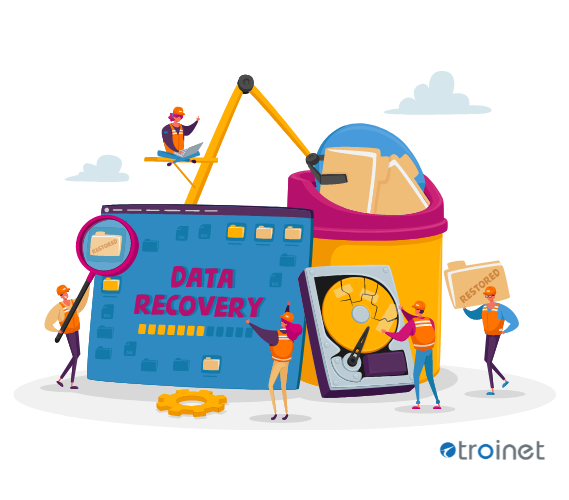When disaster strikes, we’re on your side.
Save yourself from a world of hurt and headache because of lost data that you really want back
In today’s cyber world, data is the lifeline of any organization. So if it gets deleted or deleted then you may lose your business. Hence it’s very important to secure it with immediate effect. But the matter of concern is you don’t want to lose the current work and in an argument, you lose the data as well.
For these situations, you can rely on Troinet’s data recovery services in New Jersey. We provide professional data recovery services for business hard drives, digital media, and other devices that store your valuable information. Here are reasons why data recovery is important:
- 43% of businesses admit they have suffered data loss or cyber attack
- Data disaster incidents cost $200,000 to businesses of any size on average
- The average cost per minute of unplanned downtime due to data loss or corruption is $7,900
Features

Fast and Easy
Refund Warranty
Non-Invasive
Benefits
Important file types
From Hard Drives
Affordable
Data recovery services solve these problems rapidly and restore damaged hard drives completely at affordable prices.

Data cloud backup and disaster recovery: Troinet is a data backup and disaster recovery service in New York City. We operate cloud backup services for SME’s, organizations, and firms who rely on reliable online backup to keep their business data safe from virtual disaster and make it accessible at all times.
- Protect your business from threats of data loss
- Avoid catastrophic consequences of data theft
- Reduce business downtime due to network failure
- Highly-scalable and secure platform
- Save money by eliminating the need to purchase local back-up
- Easy restore function
- Off-site mirroring
- Only pay for what you need
Benefits of Disaster Recovery and Backup Solutions
True peace of mind is knowing you're protected
- Avoid loss of money and confidence
- Lower monetary loss in case of disasters
- Create security awareness within the organization
Protection for your reputation
Avoid of loss of productivity during disasters
Disaster recovery focuses on the availability of essential applications and data after a disaster, whereas backup focuses on the confidentiality of data during a disaster. Our disaster recovery and backup plan includes maintaining offsite backups to ensure safety from natural disasters like fire, flood, and earthquake.
Give confidence to your customers and stakeholders
One of the most difficult situations to handle is an unexpected disaster. One way to be ready for disasters is through disaster recovery and backup. With these processes in place, you can have confidence that your company will keep running even if some sort of catastrophe occurs. From an IT standpoint, you need to have a backup plan before anything happens.
To gain all of these benefits and more, contact Troinet today!
Key Features of Data Backup and Disaster Recovery
Protecting your technology investment.
Easy-to-use
With a clear-cut user interface, we’ve made sure that Troinet can be used seamlessly within your own IT environment. The software offers an extensive list of features so you get exactly what you need – with minimum hassle.
We believe the best way to stop this happening to other companies is by providing them with an easy-to-use backup solution that lets them back up sensitive data in a secure location while remembering to forget about backups once they are set up.
Recover seamlessly if disaster strikes. No panic.
Offsite and cloud backup
An effective offsite and cloud backup is a combination of hardware, software, facilities, people, procedures, and management processes that protect vital data and systems from damage or interruption. It is a process or system that provides for the restoration of data, programs, and operational capabilities following the occurrence of an emergency or disaster. It should provide:
- Consistent image of all data across multiple locations.
- Rapid recovery to minimize data loss in case of disaster.
- Easy access to information off-site in case of local disasters such as fire or earthquake.
Documentation
Getting Started with Data Backup and Recovery
What is Data Backup and Disaster Recovery Solution?
Currently, backup experts recommend that companies make daily incremental backups of their critical data. These backups are then stored away in case the company needs to restore its data in the event of a major disaster such as a fire or a flood.
The most important thing to know is that when you have a backup system in place, it doesn’t matter how often you back up your data. Daily backups are best, but weekly or monthly backups are also better than no backups at all. It’s the backup system itself that matters, not how often you use it.
That’s because an effective backup system doesn’t just do one backup—it does many. If any one of those backups fails, you’ll be glad you have more than one. And if none of them fail, well then you’ll be glad for all those extra backups too.
Disaster Recovery is your insurance plan in the IT world
Lorem ipsum dolor sit amet, consectetur adipiscing elit. Ut elit tellus, luctus nec ullamcorper mattis, pulvinar dapibus leo.
Not seeing what you’re looking for? View the next steps
All Features
Peace of mind because of restore points
Patented technologies
Troinet disaster recovery solutions is a highly reliable infrastructure built on the foundation of patented technologies delivering the fastest, most dependable file access in the industry.
Works seamlessly with Microsoft and IBM systems
While TroiNet has many desirable features, one of the most useful is its ability to work seamlessly with Microsoft and IBM systems – two platforms commonly used by businesses worldwide. This makes Troinet less costly to implement than other solutions available on the market today.
Business Continuity Checklist
As COVID-19 wreaks havoc and brings uncertainty, it’s a good time to review your plan for disaster recovery. Here’s a list that can help you reduce risks and ensure business continuity beyond disastrous times. If you need help or assessment for your disaster recovery plans, please don’t hesitate to contact us.
Important! This checklist should only be used as a starting point for your Disaster Recovery Plan. This is in no way complete: we highly recommend you engage with a professional IT firm to map out a complete Disaster Recovery Plan for your business
Risk Assessment
- Define all critical functions systems, software and data in your organization.
- Prioritize the above items in order of importance to your business (mission critical to minor) based on which ones, if destroyed, would have the greatest negative impact on your business
- Create a document that outlines your current IT infrastructure network documentation) so another IT person or company could take over easily if your current IT person wasn't available, or could assist in the recovery of your IT infrastructure in the event of a disaster.
- Determine the RTO (recovery time objective), RPO (recovery point objective) and MTO (maximum tolerable outage) for every critical function and system in your business.
- Identify all threats that could potentially disrupt or destroy the above mentioned data, systems, functions, etc. and the likelihood of those threats
Mitigation and Planning Strategies
- Create an IT Assets Inventory list and identity all the functions, data, hardware and systems in your business
- Identify all potential disasters and threats to these systems and functions
- For each mission critical system or function, brainstorm ways to minimize, avoid or limit the damage done
- For the most likely disasters threats disaster recovery plan specific to what damage could be done (tornado flattens your office, city evacuation, virus attack etc.), and identify who will be responsible for executing the plan (your disaster recovery team)
- Identify recovery plan and timeline for each function and prioritize these functions by the order in which they need to be recovered if multiple mission critical functions were affected
- Create a backup strategy for your data and systems
- Create a testing and validation strategy, and schedule tests for your backups
- Define your communication plan in the event of a disaster employees, clients, vendors and the media
- Create a “break the glass” document that contains instructions on what to do if key executive dies, is disabled, or is otherwise unavailable long period of time
- Review your current insurance policy to make sure you have sufficient coverage to replace the assets in your organization
- Define a media communication strategy (how you will communicate with the press disaster happens)
- Summarize this into a disaster recovery plan and brief the disaster recovery team on the plan
- Schedule a periodic meeting to review and update the plan with your disaster recovery team

